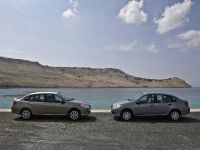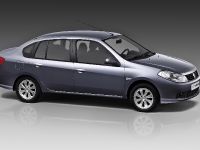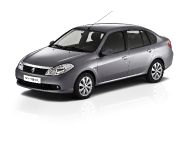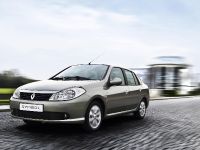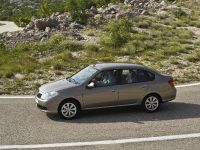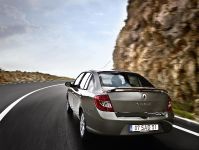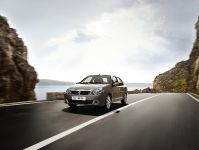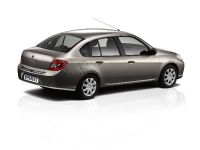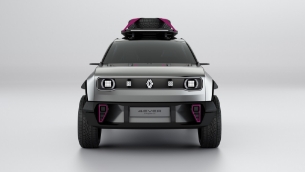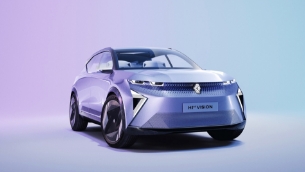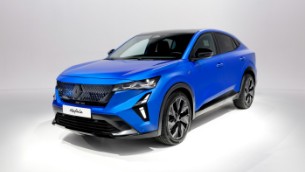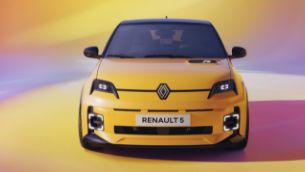New Renault Symbol, an elegant three-box saloon with seductive appeal
Renault has profited from the Moscow Motor Show to reveal Renault Symbol, the latest vehicle to join its line-up as part of the Renault Commitment 2009 plan.
The lines of this three-box saloon suggest refinement and elegance, and its status-enhancing front-end looks are underpinned by the design of the headlamps and the specific grille which is picked out in chrome. The robust lines of the rear are also suggestive of status, while the cabin is comfortable and carefully appointed.
Renault Symbol is truly economical to run. Its range of latest-generation engines all combine performance, fuel efficiency and respect for the environment. Both the petrol- and diesel-powered versions of this vehicle can claim best in class fuel consumption, returning a low 4.3 litres/100km (equivalent to CO2 emissions of 116g/km) with the 1.5 dCi 85hp engine, and 5.9 litres/100km (equivalent to CO2 emissions of 140g/km) with the 1.2 16V 75hp powerplant.
Renault Symbol sets standards when it comes to travelling comfort, too. The running gear is inherited from that of Clio II which is acclaimed for the first class balance it strikes between comfort and roadholding. Passengers will also appreciate the quiet drive ensured by the thoroughly soundproofed cabin, while thermal comfort has been engineered to function in the extreme climates of countries like Russia, Turkey, etc.
The large (506 dm3), practical boot meets the needs of a wide variety of uses, ranging from family holidays, professional use or a weekend away in the country. And this three-box car is equally uncompromising in the realm of, delivering optimal protection for all occupants.
Renault Symbol has plenty of arguments in its favour to win over families in Central and Eastern Europe, Russia, Turkey, the Maghreb countries and the Gulf States. Indeed, this vehicle heralds the forthcoming renewal of Renault's entire three-box line-up and is due to be released for sale on the majority of its markets between September and November 2008.
Status symbol
Renault has chosen the Moscow Motor Show to take the wraps off Renault Symbol, the first three-box saloon to form part of the Renault Commitment 2009 plan. This model was designed to meet customer demand in such dynamic markets as Russia and Turkey. Renault Symbol is the fruit of international cooperation between different Renault engineering departments.
Close collaboration between Renault engineering teams, plus best level quality Renault Symbol was developed over a period of 26 months. Digital technologies including modelling and dynamic simulation were employed at every step of the project which resulted in both time and cost savings. The total capital outlay for Renault Symbol – including production-related investment – was €100 million. The use of the running gear from Clio II, itself a benchmark in its segment in terms of comfort and roadholding, permitted design lead times to be kept to a minimum while ensuring an extremely high level of quality.
Although Clio Symbol was derived from Clio II, Renault Symbol is a model in its own right. Designed jointly by Renault engineering teams at the Technocentre (France), in Turkey and in Romania, it is manufactured at the Oyak-Renault plant in Bursa, Turkey, one of the Renault Group's leading factories in terms of quality. It is both ISO 9001- and ISO 14001-certified and employs the production methods spelled out in the Renault Production Way (SPR). Quality control also covers the management of this factory's diversified production which manufactures five different body types on the same line. Bursa's capacity is 360,000 units in three shifts for the five models it produces, namely Renault Symbol, three- and five-door Clio III, Clio Estate and four-door Megane saloon.
A vehicle aimed at promoting growth outside of the Europe region The decision to manufacture Renault Symbol in Bursa was taken at a very early stage in the project in order to ensure its production as near as possible to the countries where it would be sold. Indeed, Russia, Turkey, Romania and Algeria are key markets for this model and are expected to absorb more than 80 per cent of production. The rest of production will go to the CEEC (Central and Eastern Europe countries), the Middle East and Africa.
This three-box car targets automobile markets that are enjoying strong growth. Between 2000 and 2007, the BRIC countries (Brazil, Russia, India and China) grew by 176 per cent, while growth economies such as the Maghreb countries and Turkey grew by 87 per cent, and mature markets (Western Europe, North America and Japan) receded by 4.5 per cent. Forecasts expect this trend to be even more marked in years to come.
In this highly competitive marketplace which has seen a significant renewal of the offer, Renault Symbol has many arguments in its favour, beginning with the brand's performance in this segment. Clio Symbol has been a success story since 2000, with sales totalling more than 600,000 units. It was once again Turkey's best-selling car in 2007. Up to the end of April 2008, Clio Symbol topped its segment in Turkey and was second in Romania, Morocco and Algeria.
Renault Symbol, tailor-made for its markets Renault Symbol reaps the benefit of the organization by regions introduced by Renault in 2006 and which features regular meetings between all the key local players and representatives of centrally-based functions for a more streamlined decision-making process in tune with the needs of the marketplace.
The Euromed1 region was closely involved in the project, notably in terms of deciding the specification of the car and then forecasting sales volumes.
Customer surveys and feedback from the field conducted at a very early stage in the project enabled a detailed analysis of the segment to be made with a view to producing a vehicle that perfectly matched customer demand. Two major factors stood out as essential, namely exterior looks and low running costs (fuel consumption, upkeep and servicing).
Despite variations from one market to another, this process outlined the principal characteristics of the typical Renault Symbol buyer who is male and looking for a spacious family car that is comfortable, easy to run and versatile (family journeys, travelling to and from work). The typical buyer is also looking for the best quality-to-price ratio, as well as a safe, attractive car. Brand image is seen as important, too.
Renault Symbol is the first step in the creation by Renault of a range of three-box models. This will enable the brand to build on the thousands of satisfied Clio Symbol buyers and also win over customers thanks notably to the newcomer's statusenhancing looks and extremely competitive running costs.
The car is due to be released for sale on the majority of its markets between September and November 2008.
ELEGANCE AND SEDUCTIVE APPEAL
Symbol's status-enhancing front-end looks and harmonious styling exude refinement and elegance. Inside, the driver and passengers will appreciate the comfortable, carefully-appointed cabin.
Elegant, status-enhancing lines
Renault Symbol is a three-box saloon which features attractive styling. It sits on 14- or 15-inch wheels, while its length of 4.26 metres and height of 1.43 metres ensure nicely balanced proportions. The harmonious forms of its headlamps combine with the foglamps and body colour exterior mirrors (except entry level version) to underpin the front end's status-enhancing looks. Seen from the side, its lines are those of a prestigious saloon and the presence of a third lateral window ensures first class visibility. The robust design of the rear is also suggestive of status, an impression which is compounded by the body colour rear bumper and wrap-round rear lights. The use of chrome trimming for the grille surround, rear panel and exterior door handles adds a further note of refined distinction (depending on equipment level). Renault Symbol can also be ordered with a rear wing (available as an accessory) and 15-inch aluminium alloy wheels which give it further poise and dynamic appeal.
A comfortable, carefully-appointed cabin
The same seductive appeal and level of perceived quality are apparent inside Renault Symbol, too. The practical interior exudes a sensation of comfort and well-being, while the trim strip of the dashboard brings an added touch of elegance and refinement. The dashboard itself features a rev-counter, warning lights and the trip computer display. The gearlever knob falls readily to hand, while appointments include a chrome steeringwheel trim (depending on version) and the height-adjustable driver's seat.
INEXPENSIVE TO RUN
Renault Symbol is genuinely inexpensive to run. Its range of latestgeneration powerplants combines performance, fuel efficiency and respect for the environment. The diesel 1.5 dCi 85hp and petrol 1.2 16V 75hp engines deliver best in class fuel consumption of 4.3 litres/100km (equivalent to CO2 emissions of 116g/km) and 5.9 litres/100km (equivalent to CO2 emissions of 140g/km) respectively.
Best level fuel efficiency
Renault Symbol features segment-leading fuel consumption performance. In their respective categories, the 1.5 dCi 85hp diesel engine and the petrol 1.2 16V 75hp return record low combined cycle fuel consumption and CO2 emissions for a three-box vehicle of this size, i.e. 4.3 litres/100km (equivalent to CO2 emissions of 116g/km) and 5.9 litres/100km (equivalent to CO2 emissions of 140g/km).
To achieve such low figures, Renault's engineers paid especially close attention to Renault Symbol's aerodynamics (CdA = 0.691) and to keeping weight to a minimum. Indeed, the 1.2 16V 75hp-powered version tips the scales at a low 904kg to give it a best level performance-fuel consumption ratio. Renault Symbol contributes actively to the '120-140' pledge outlined in the Renault Commitment 2009 plan which saw Renault commit to selling one million vehicles in 2008 that emit less than 140g of CO2/km, including one third that emit less than 120 g/km.
A range of engines that combine performance and low running costs
The Renault Symbol range features the latest-generation engines that power all Renault's entry level range (Twingo, Clio and Modus), providing the market's best level fuel consumption, performance and acoustic comfort. Depending on country and equipment level, the petrol engine range comprises the 1.2 16V 55kW (75hp), the 1.4 55kW (75hp), the 1.4 16V 72kW (98hp) and the 1.6 16V 77kW (105hp). Meanwhile, the 1.5 dCi diesel engine is available in a choice of two power outputs: 48kW (65hp) and 62kW (85hp). Depending on market, these engines comply with Euro1, Euro3 or Euro4 depollution standards. The two most powerful petrol engines can be mated with fourspeed proactive automatic transmission.
The petrol engine range
1.2 16V 75hp
The 1,149cc 1.2 16V (D4F) has a power output of 75hp (55kW) at 5,500rpm and delivers torque of 105Nm (10.7mkg) at 4,250rpm. In addition to this engine's linear power curve, the torque is available from very low revs, making it a particularly versatile engine suited to all types of journey. 90 per cent of peak torque is available over a broad rev band that extends from 1,750 to 5,750rpm. The overhead camshaft with roller cam followers and specific inlet calibration have enabled the idling speed to be kept to a low 650rpm which translates into a fuel saving of between two and three per cent when driving in town. Powered by this engine, Renault Symbol returns the best combined cycle fuel consumption of its class with a score of just 5.9 litres/100km (equivalent to CO2 emissions of 140g/km).
1.4 75hp
With a power output of 55kW (75hp) at 5,500rpm, this 1,390cc engine (K7J) is acclaimed for its robustness and reliability. It combines punch with a comfortable, enjoyable drive. Peak torque of 114Nm (11.6mkg) at 5,500rpm brings out the best in Renault Symbol's versatility in built up areas and in open country.
1.4 16V 98hp
The maximum power output of this 1,390cc engine is 72kW (98hp) at 6,000rpm to ensure genuine driving pleasure. Peak torque is 127Nm (12.9mkg), 90 per cent of which is available between 2,000 and 5,750rpm. Depending on market, this engine can be ordered with either four-speed proactive automatic transmission or a five-speed manual gearbox.
1.6 16V 105hp (77kW)
The 1.6 16V (K4M) puts out 105hp (77kW) at 6,000rpm and peak torque of 148Nm (15.8mkg) at 3,750rpm. With 90 per cent of the latter available between 2,000 and 5,750rpm, this 1,598cc unit is responsive and pleasant to drive. Fuel consumption has been minimized thanks to the use of roller cam followers and lightweight materials. It is available exclusively with four-speed proactive automatic transmission.
The diesel engine range
1.5 dCi
The diesel range is founded on the 1.5 dCi (K9K) engine, the second-generation 1,600- bar Common Rail injection system of which ensures enhanced combustion quality and, as a result, lower fuel consumption. This engine is acclaimed for its efficiency and acoustic performance, thanks notably to its so-called flexible flywheel which filters out the effects of acyclic movements. This 1,461cc engine is available in a choice of two power outputs:
- 48kW (65hp): The maximum torque (160Nm/16.3mkg) of this version of the 1.5 dCi is available from very low revs and ensures responsive mid-range acceleration. It is ideally suited to Renault Symbol's versatility and allows all types of journey to be envisaged. Low fuel consumption is a feature of the model powered by this engine.
- 62kW (85hp): This more powerful version of the 1.5 dCi packs an even bigger punch. Thanks to its low inertia turbo and torque of 200Nm (18.9mkg) available from 1,750rpm, it is particularly enjoyable and comfortable to drive. It claims the best fuel consumption of its class with just 4.3 litres/100km over a European-type combined cycle (equivalent to 116g/km of CO2). This version complies with Euro4 antipollution standards.
A TOTALLY REASSURING RIDE
Renault Symbol offers benchmark travelling comfort and employs the same running gear as Clio II which is acclaimed for the balance it strikes between comfort and outstanding roadholding. Passengers will also appreciate the particularly quiet ride, while thermal comfort has been tailored to deliver top performance in a wide variety of climates, from extreme heat to extreme cold.
Outstanding handling
The handling of Renault Symbol is predictable in all situations, even on wet roads. The choice of the same running gear as Clio II, a front track dimension of 1.41m and a wheelbase of 2.47m ensure pleasant, surefooted and surprise-free stability and handling. The roadholding has been engineered with two priorities in mind: safety and comfort. The MacPherson-type front suspension has been calibrated to deliver optimal handling and ride comfort.
It employs hydraulic dampers and coil springs, and comes with an antiroll bar to minimize body-roll. The diameter of the anti-roll bar is 23mm in the case of versions powered by the 1.2 or 1.4 75hp petrol engines, and 24mm in the case of the other models.
The rear suspension is based on a compact and lightweight programmed deflection Hbeam system. Ride comfort is enhanced by the combination of vertically-mounted dampers, variable-rate coil springs and rubber top and bottom spring mountings which effectively filter out the transmission of vibrations to the bodyshell.
Effective stopping power
For advanced braking performance, Renault Symbol is equipped with solid or vented discs (diameter: 238mm or 259mm) depending on engine, while most versions feature eight-inch drums at the rear. The vehicle can be ordered with ABS and electronic brakeforce distribution. The power steering ensures precise steering and heightens the sense of safety at higher speeds.
Top level soundproofing
Renault Symbol boasts best in class acoustic and anti-vibration performance. The choice of the Clio II platform ensures that the cabin is effectively soundproofed. The seal at the base of the windscreen and the use of specific mousse and damping materials for the dashboard and dashboard cowling cut the transmission of powertrain-generated noise and vibrations not only to the cabin but to the outside, too. The addition of extra soundproofing materials such as thicker mousse panels also contributes to minimizing wind and road noise.
Pleasant thermal comfort
Renault Symbol's thermal comfort has been engineered to meet to the demands dictated by the climates found in a variety of countries. The routing of the vent ducts has been specially thought through to ensure that the temperature climbs rapidly when starting, especially in extreme cold.
Depending on market, Renault Symbol features:
- an air conditioning system designed for fast, efficient production of cold air (optional),
- a climate control system designed to keep the cabin temperature consistent (optional),
- high capacity production of warm air,- effective defrosting performance and a flow of warm air delivered rapidly and evenly across the full windscreen.
The 1.5 dCi engine is equipped with thermoplungers. This additional electric heating accelerates defrosting and the activation of the heating system. In certain countries such as Russia, the seat backs and cushions can be heated.
A PRACTICAL CAR WITH TOP LEVEL SAFETY
Thanks to its practical and generously dimensioned boot (506dm3), Renault Symbol is ideally suited to a wide variety of lifestyles and uses, including family holidays, professional needs and weekends away in the country. The car is uncompromising, too, when it comes to safety and ensures optimal protection for all occupants.
Large, practical boot
Renault Symbol features one of the largest boots of its class. Its capacity of 506dm3, flat floor and width (>1.10m) make it ideal for all situations, from family holidays to weekends away in the country. The front and rear (depending on version) doors incorporate large stowage bins, while the dashboard houses a six-litre lidded glovebox. Depending on version, stowage solutions can also include map pockets on the backs of the front seats.
Effective occupant protection
Renault Symbol benefits from Renault's extensive expertise in the realm of safety. To guarantee optimal protection for all occupants, this three-box model features a long list of safety-enhancing features, not the least of which is the use of high elastic limit (HLE) steel which ensures a strongly resistant cabin while at the same time limiting the latter's deformation, notably in the case of frontal impact.The way its reinforced structure crumples under impact is dictated by pre-programmed properties. The subframe and front bumper beam have been optimized. In the case of side impact, occupants are protected by lateral anti-intrusion reinforcement in the front and rear doors.
Renault Symbol comes as standard with a driver's side airbag, to which it is possible to add a front passenger airbag and two lateral thorax airbags (depending on version) for further occupant protection from side impact.
Occupant restraint can also be enhanced by pyrotechnic pretensioners for the front seats to optimize the way passengers are held in place. Renault Symbol is equipped with five three-point seatbelts. The front seatbelts incorporate load limiters to protect the thorax. Depending on version, these three-point seatbelts are heightadjustable to ensure optimal comfort and passenger restraint under impact.
The front and rear (depending on equipment level) adjustable headrests have been designed to avoid injury to the cervical vertebrae in the case of rear impact. These headrests improve the position of the back, as well as the restraint and comfort of the head. Last but not least, for the safety of young passengers, Renault Symbol's outer rear seats are equipped as standard with Isofix anchorage, as well as kiddy locks for the rear doors.
